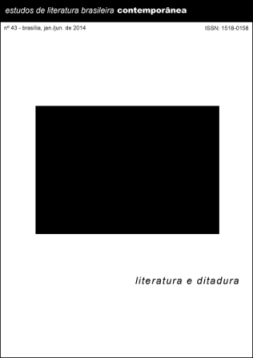Memórias manchadas e ruínas memoriais em A mancha e “O condomínio”, de Luis Fernando Veríssimo
DOI:
https://doi.org/10.1590/S2316-40182014000100005Resumo
Este artigo propõe que locais esquizofrênicos da memória ”“ locais construídos como palimpsestos de várias (e muitas vezes contraditórias) versões do passado ”“ estão conectados com o que o antropólogo James Holston (2008) denomina de “cidadania diferenciada”. O artigo estabelece uma analogia entre os direitos diferenciados da memória e as disposições constitucionais que legalizam as diferenças sociais e civis e que, segundo Holston, são uma das características da cidadania diferenciada.
Downloads
Referências
ABRÃO, Paulo; TORELLY, Marcelo D. (2012). Resistance to change: Brazil's persistent amnesty and its alternatives for truth and justice. In: LESSA, Francesca; PAYNE, Leigh A. (Eds.). Amnesty in the age of human rights accountability: comparative and international perspectives. Cambridge: Cambridge University Press.
AGAMBEN, Giorgio (2005). State of exception. Chicago: University of Chicago Press.
ARENDT, Hannah (1951). The origins of totalitarianism. New York: Harcourt, Brace and Co.
ATENCIO, Rebecca (2014). Memory’s Turn: reckoning with dictatorship in Brazil. Madison: University of Wisconsin Press.
AVELAR, Idelber (1999). The untimely present: postdictatorial Latin American fiction and the task of mourning. Durham: Duke University Press.
BAUMAN, Zygmunt (2004). Wasted lives: modernity and its outcasts. Oxford: Polity.
BRASIL (1979). Lei 6.683, de 28 de agosto. Concede anistia e dá outras providências. Disponível em: <http://www.planalto.gov.br/ccivil_03/leis/L6683.htm. Acesso em: 10 mar. 2014.
CALDEIRA, Teresa P. R. (2000). City of walls: crime, segregation, and citizenship in São Paulo. Berkeley: University of California Press.
CANO, Ignacio; FERREIRA, Patricia S. (2006). The reparations programs in Brazil. In: GREIFF, Pablo (Ed.). Handbook of reparations. Oxford: Oxford University Press.
COMITÊ CARLOS DE RÉ. Disponível em: <http://comitedaverdadeportoalegre.wordpress.com>. Acesso em: 20 mar. 2013.
DECLARAÇÃO UNIVERSAL DOS DIREITOS HUMANOS. Disponível em: <http://portal.mj.gov.br/sedh/ct/legis_intern/ddh_bib_inter_universal.htm>. Acesso em: 05 mar. 2013.
GINZBURG, Jaime (2010). Escritas da tortura. In: TELES, Edson; SAFATLE, Vladimir (orgs.). O que resta da ditadura: a exceção brasileira. São Paulo: Boitempo.
HITE, Katherine (2011). Politics and the art of commemoration: memorials to struggle in Latin America and Spain. New York: Routledge.
HOLSTON, James (2008). Insurgent citizenship: disjunctions of democracy and modernity in Brazil. Princeton: Princeton University Press.
JELIN, Elizabeth; REIN, Judy; GODOY-ANATIVIA, Marcial (eds.) (2003). State repression and the labors of memory. Minneapolis, University of Minnesota Press.
LAZZARA, Michael J.; UNRUH, Vicky (2009). Introduction: telling ruins. In: LAZZARA, Michael; UNRUH, Vicky (Eds.). Telling ruins in Latin America. New York: Palgrave Macmillan.
MARSIGLIA, Ivan (2012). E o direito à memória bateu à porta. O Estado de S. Paulo, São Paulo, 26 ago. Caderno Aliás. Disponível em: <http://www.estadao.com.br/noticias/impresso,e-o-direito-a-memoria-bateu-a-porta,921878,0.htm>. Acesso em: 10 mar. 2014.
MEZAROBBA, Glenda (2010). Between reparations, half truths and impunity: the difficult break with the legacy of the dictatorship in Brazil. Sur - Revista internacional de direitos humanos, São Paulo, v. 7, n. 13, p. 7-25.
MITCHELL, José (2007). Segredos à direita e à esquerda na ditadura militar. Porto Alegre: RBS.
O’DONNELL, Guilermo et al. (1986). Transitions from authoritarian rule. Baltimore: Johns Hopkins University Press.
PIOVESAN, Flávia (2010). Direito internacional dos direitos humanos e lei de anistia: o caso brasileiro. In: TELES, Edson; SAFATLE, Vladimir (orgs.). O que resta da ditadura: a exceção brasileira. São Paulo: Boitempo.
PROGRAMA NACIONAL DOS DIREITOS HUMANOS (PDH) (2010). Disponível em: <http://portal.mj.gov.br/sedh/pndh3/index.html>. Acesso em: 09 mar. 2014.
RANGEL, Carolina (2013). Vingança é o objetivo. Veja, São Paulo, 29 mai. p. 76-78.
SIKKINK, Kathryn (2011). The justice cascade: how human rights prosecutions are changing world politics. New York: W. W. Norton & Co.
SIKKINK, Kathryn; WALLING, Carrie B. (2007). The impact of human rights trials in Latin America. Journal of peace research, Oslo, v. 44, n. 4, p. 427-445.
UNESCO Office in Brasilia. Human rights in Brazil. Disponível em: <http://www.unesco.org/new/en/brasilia/social-and-human-sciences/human-rights>. Acesso em: 10 mar. 2014.
SCARRY, Elaine (1987). The body in pain: the making and unmaking of the world. New York: Oxford University Press.
STERN, Steve J. (2006). Battling for hearts and minds: memory struggles in Pinochet’s Chile. Durham: Duke University Press
TEITEL, Ruti G. (2000). Transitional justice. Oxford: Oxford University Press.
VERÃSSIMO, Luis Fernando (1982). O condomínio. In: Outras do analista de Bagé. Porto Alegre: L&PM.
________ (2004). A mancha. São Paulo: Companhia das Letras.
WILCKEN, Patrick (2012). The reckoning. Investigating torture in Brazil. New left review, London, n. 73, p. 63-78.
Downloads
Publicado
Como Citar
Edição
Seção
Licença
Autores que publicam nesta revista concordam com os seguintes termos:
a) Os(as) autores(as) mantêm os direitos autorais e concedem à revista o direito de primeira publicação, sendo o trabalho simultaneamente licenciado sob a Licença Creative Commons de Atribuição-Não Comercial 4.0, o que permite o compartilhamento do trabalho com reconhecimento da autoria do trabalho e publicação inicial nesta revista.
b) Os(as) autores(as) têm autorização para assumir contratos adicionais separadamente, para distribuição não-exclusiva da versão do trabalho publicada nesta revista (ex.: publicar em repositório institucional ou como capítulo de livro), com reconhecimento de autoria e publicação inicial nesta revista.
c) Autores têm permissão e são estimulados a publicar e distribuir seu trabalho on-line (ex.: em repositórios institucionais ou na sua página pessoal) após o processo editorial, já que isso pode gerar alterações produtivas, bem como aumentar o impacto e a citação do trabalho publicado (Veja O Efeito do Acesso Livre).
d) Os(as) autores(as) dos trabalhos aprovados autorizam a revista a, após a publicação, ceder seu conteúdo para reprodução em indexadores de conteúdo, bibliotecas virtuais e similares.
e) Os(as) autores(as) assumem que os textos submetidos à publicação são de sua criação original, responsabilizando-se inteiramente por seu conteúdo em caso de eventual impugnação por parte de terceiros.


